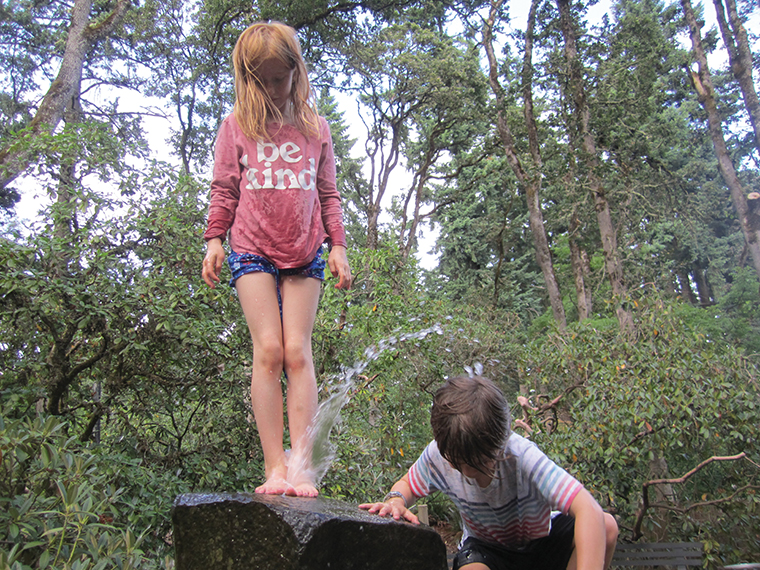By Chris Roth

After the tribulations described in Seizing the Torch (Communities #185), Maple Creek founder (not really) shows Fir Ridge founder (not really) how to go with the flow.
Issue #185’s “Seizing the Torch” (pages 38-42) described Maple Creek’s near-collapse from an ill-advised torch-seizure, and promised a future article about the community’s recovery. Space constraints do not allow that story to be told in its entirety here; instead, at the risk of promoting a “tell, don’t show” philosophy (still preferable to “don’t ask, don’t tell” or “do as I say, not as I do”), here are key points this article would have made:
● A complete enough collapse of a community governance system that is not working provides ideal conditions for the birth or rebirth of something that does—including the resurrection of a past system that did, for the most part, work, with modification to meet new conditions and past shortcomings.
● When left to experiment, to engage in a process of trial and error, to take advantage of collective wisdom, a group rebuilding from collapse may well end up replicating elements of governance and culture that distinguished its pre-collapse success. This may happen even if the majority of the people involved in designing these new systems have no personal experience or even knowledge of the previous systems.
● When used with proper training and understanding, democratic decision-making and governance systems such as consensus and sociocracy are much more likely to result in a resilient community than systems that concentrate power in the hands of a few. This is especially true in an organization which attracts self-actualized individuals who distrust unearned power and question authority when it is not aligned with the common good.
● Clarity of vision and the ability to articulate it can be crucial in attracting what one wants in a community and its members, and discouraging what one doesn’t want.
● Clear guidelines about what constitutes acceptable and unacceptable behavior in community can be essential in encouraging more of the former and less of the latter—especially in groups that are too large and fluid in membership to be able to rely on personal trust and connection to maintain a culture that works for all.
● Making room for each person’s agency, providing ways for each individual to access roles that allow them to contribute to the group, can create a community of leaders rather than one fragmented into those with and without significant power or influence over group life.
● Especially when certain tasks or areas are delegated to smaller groups or to individuals, transparency in decision-making and group process is essential in maintaining trust and connection.
● A healthy group incorporates practices and formats that encourage individuals to share honestly with each other, devotes time to building personal connections among members (both in organized well-being-focused meetings and in less formal settings), and makes self-disclosure and vulnerability not only an acceptable element of the group culture, but one that is valued. This approach creates more security in community than any amount of material improvement in circumstance (except when actual physical survival is threatened, in which case first things need to come first).
● It is possible to balance emotion and rationality, feeling and thought, compassion and fairness, adaptability and consistency, spontaneity and predictability, art and science, work and play, reassuring harmony and creative dissonance. A properly functioning group within a supportive structure organically self-corrects and balances itself out in all of these areas—not always in the moment, but over time. Groups learn from their mistakes and, when given an opportunity, improve in their ability to address both familiar and new challenges.
● Food—meals prepared for one another and eaten together—is a powerful bonding force. Frequency of and attendance at shared meals often correlate directly with the amount of connection members of a community feel.
● “Progress” is not linear and it is always possible to slip back into patterns a group believed it had transcended, or to confront anew challenges it imagined it had left behind. But, especially when members stick around for the long haul, these patterns and challenges do become easier to address.
● Accepting the cyclical nature of community issues and the predictable fluctuations in community mood also becomes easier the more we experience them. Repetitions of patterns can provoke new or deeper insights; circling back around to something temporarily left behind may result in new appreciation. Despite his mirth-inspiring fight with Ezra Pound in the captain’s tower, perhaps the poet had it right: the end of all our exploring may be to arrive where we started (or at least where we have already been) and know the place for the first time.
Chris Roth edits Communities.
Excerpted from the Spring 2020 edition of Communities (#186), “Picking Up the Pieces: New Beginnings.”
